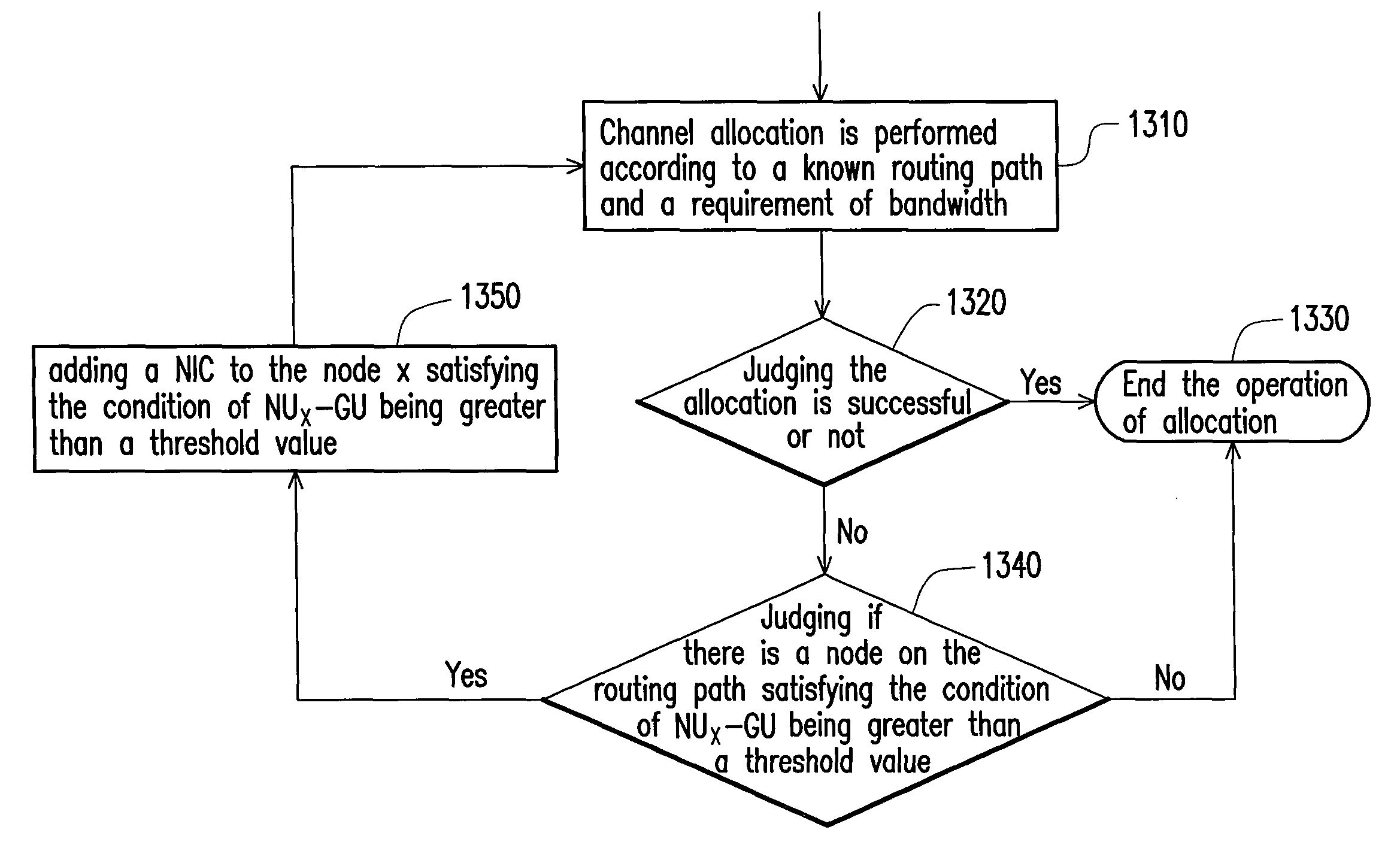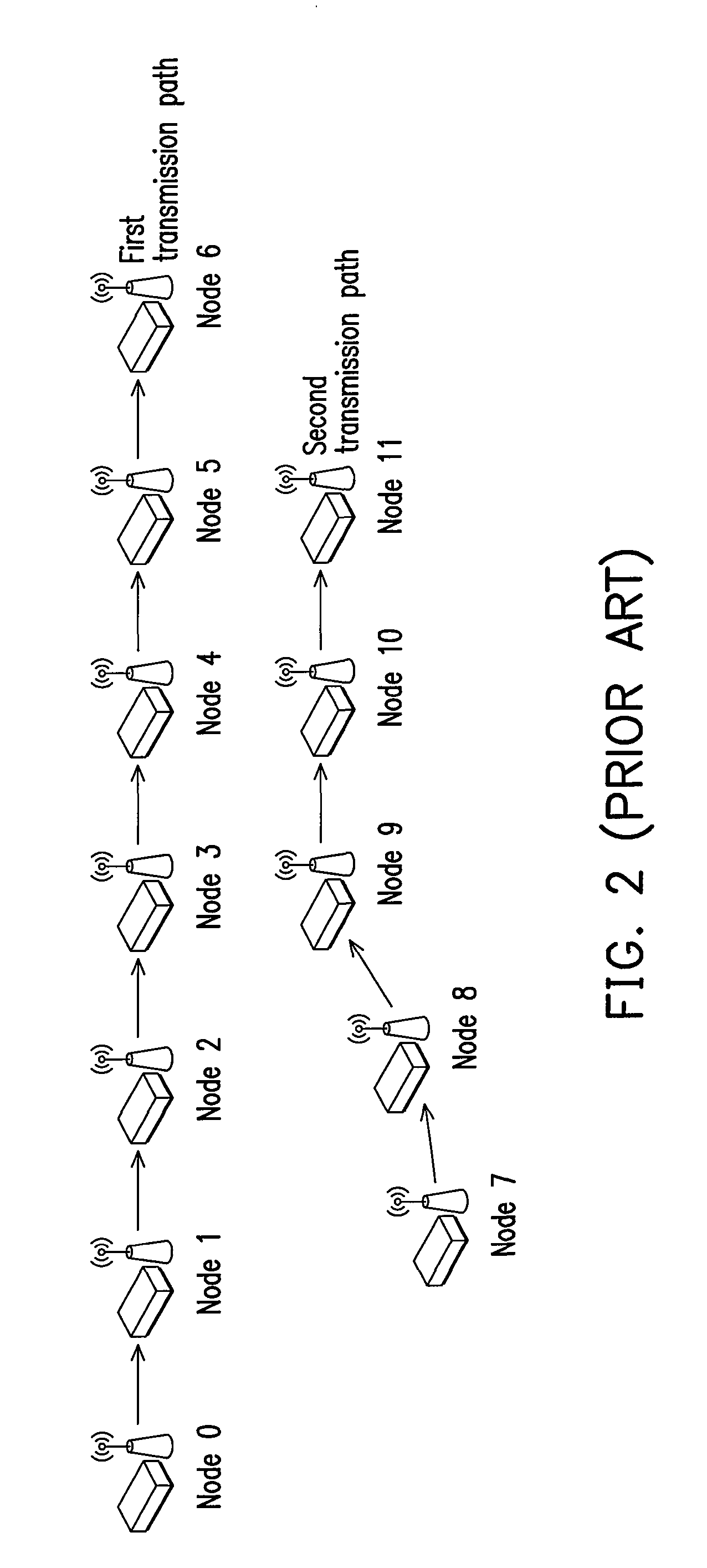Distributed channel allocation method and wireless mesh network therewith
a wireless mesh network and channel allocation technology, applied in wireless communication services, wireless commuication services, electrical appliances, etc., can solve the problems of inability to avoid interference in the above-mentioned techniques, limited application of the method, and reduced data transmission rate of the network link layer, so as to achieve the effect of avoiding interference among nodes and ensuring the application of bandwidth
- Summary
- Abstract
- Description
- Claims
- Application Information
AI Technical Summary
Benefits of technology
Problems solved by technology
Method used
Image
Examples
first embodiment
Basic Channel Allocation Method
[0072]First, a network structure with a single timeslot, four channels, and four NICs is taken for an example to explain the channel allocation method. Since there is only a single timeslot, an individual NIC can merely communicate with another NIC synchronously. Therefore, in this example, the number of the NICs on each node is assumed to be equal to the number of the non-overlapping channels.
[0073]First, a three-tuple (a1, a2, a3) is defined as a combination of correlative free channels, wherein a3 is the free channel of the present link, a2 is the free channel of the previous link, and a1 is the free channel of the previous two links. FIG. 6 is a calculated result of FIG. 5. FC(u,v) represents the free channel from a node u to a node v, whereas FCSPn represents a path selected by the three-tuple in the present embodiment.
[0074]The following formulas denote the definition of the free channel combination FCSPn:
FCSPn≡{(c1,c2,c3)|c1εFCPn-2, c2εFCPn-1, c...
second embodiment
The Second Embodiment
Sharing The Allocated Transmission Path by Distribution in Priority
[0079]To expanding the method of the first embodiment, a further embodiment is provided, wherein the allocated transmission paths can be shared according to the channel allocation method of the present invention, and the utilization efficiency of the network can be greatly improved. FIG. 8 represents a modified FIG. 4. Besides, it is assumed that the allocated channels already exist between nodes n1 and n2, nodes n2 and n3, nodes n3 and n4, and that the channels are transmitting packets, shown as arrows of reference numerals 810, 820 and 830. Referring to FIG. 8, a first channel is already allocated between the nodes n1 and n2, a third channel is already allocated between the nodes n2 and n3, and a fourth channel is already allocated between the nodes n3 and n4. If the remaining bandwidth of the allocated channels is greater than the bandwidth required for the routing path to be established, the ...
third embodiment
The Third Embodiment
Channel Allocation Method of Multi-Timeslots, Multi-Channels And Unique NIC
[0082]Another feature of the present invention will be described in the present embodiment. A time division technique is introduced to the previous channel allocation method, by which the number of the NICs on the receiving node and the transmitting node are allowed to be asymmetric. A situation of three timeslots, four non-overlapping channels and one NIC for each node is taken for an example to describe the channel allocation method of the present invention.
[0083]Referring to FIG. 10, it should be noted that the channel utilization is categorized into four states: transmitting (T), receiving (R), interfered (I) and free (F). In FIG. 11, the “T” state is shown by left-slanted lines, which represents the channel is transmitting packets. The “R” state is shown by right-slanted lines, which represents the channel is receiving the packets. The “I” state is shown by cross lines, which represen...
PUM
 Login to View More
Login to View More Abstract
Description
Claims
Application Information
 Login to View More
Login to View More - R&D
- Intellectual Property
- Life Sciences
- Materials
- Tech Scout
- Unparalleled Data Quality
- Higher Quality Content
- 60% Fewer Hallucinations
Browse by: Latest US Patents, China's latest patents, Technical Efficacy Thesaurus, Application Domain, Technology Topic, Popular Technical Reports.
© 2025 PatSnap. All rights reserved.Legal|Privacy policy|Modern Slavery Act Transparency Statement|Sitemap|About US| Contact US: help@patsnap.com



